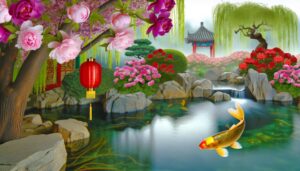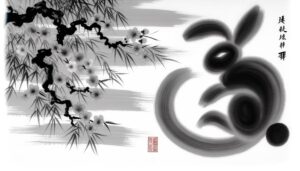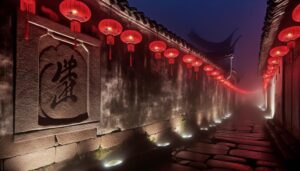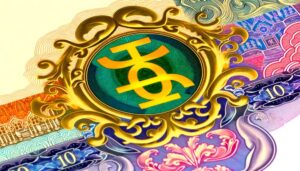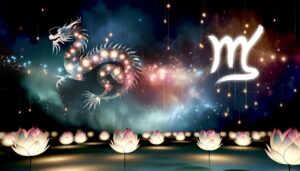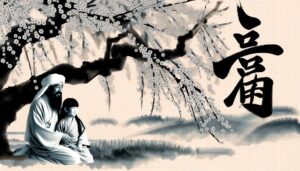What Animal Symbolizes Chinese New Year 2024?
The symbol for Chinese New Year 2024 is the Dragon, representing a profound emblem in Chinese culture. Historically tied to imperial power and authority, the dragon is a symbol of grandeur, strength, wisdom, and protection.
In ancient folklore, dragons controlled natural elements and maintained harmony between heaven and earth. The Dragon's presence during celebrations signifies prosperity and good fortune.
Traditional practices such as dragon dances invoke these themes, and modern interpretations continue to highlight the dragon's cultural significance. This rich tapestry of symbols and traditions offers a deeper understanding of the profound cultural values embedded in Chinese New Year.
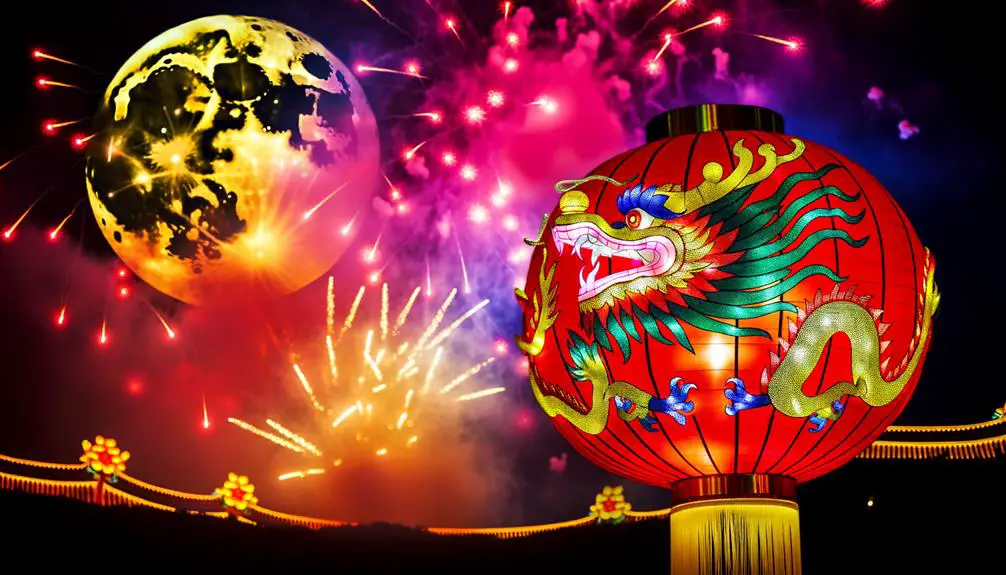
Key Takeaways
- The symbol for Chinese New Year 2024 is the dragon, representing power, wisdom, and auspiciousness.
- Dragons in Chinese culture symbolize grandeur, strength, and protection, reflecting the year's theme.
- Traditional celebrations include dragon dances, which invoke power and auspiciousness.
- Festive foods like dumplings and Nian Gao symbolize wealth, abundance, and progress.
- Red envelopes, symbolizing happiness and blessings, are a key tradition during Chinese New Year.
Year of the Dragon
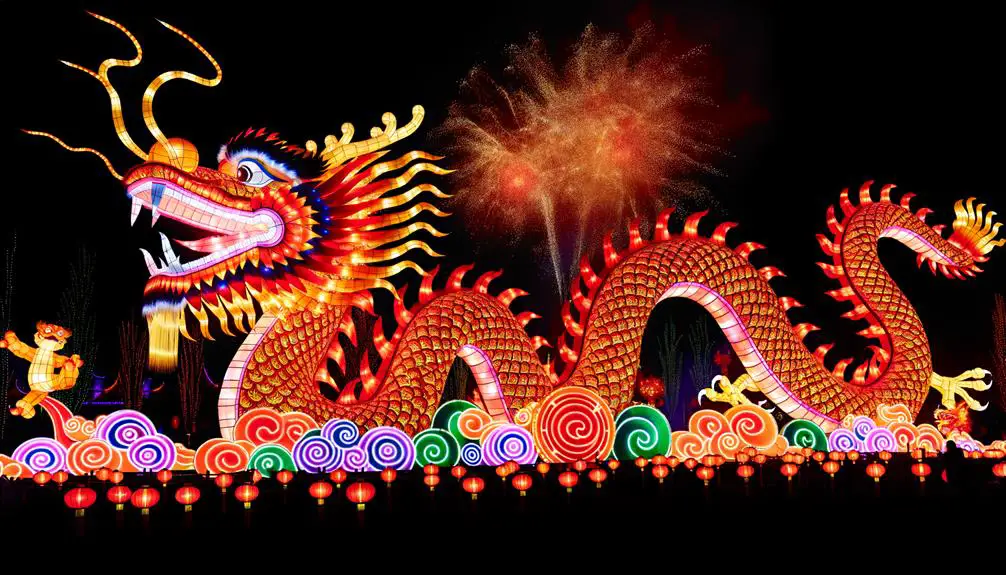
The year 2024 marks the return of the Year of the Dragon in the Chinese zodiac, a period imbued with significant historical and cultural symbolism. This cyclical event recurs every twelve years, each time evoking a sense of renewal and anticipation.
Historically, the dragon has been venerated in Chinese mythology and folklore, often associated with imperial power and auspiciousness. The Year of the Dragon is traditionally seen as a time of power, essentiality, and growth, reflecting the qualities attributed to the mythical creature.
This year, communities across the globe will engage in a variety of cultural practices and festivities, deeply rooted in ancient traditions, to honor the dragon's return. These celebrations foster communal bonds and cultural continuity.
Dragon Symbolism
Exploring dragon symbolism reveals a rich tapestry of meanings that span power, wisdom, and auspiciousness, deeply embedded in Chinese cultural and historical contexts.
The dragon, or 'long' (龙), has been revered in China for millennia, embodying imperial authority and celestial prowess. Traditionally, it was believed to control natural elements like rain and wind, symbolizing the harmony between heaven and earth. Dragons often adorned the regalia of emperors, emphasizing their divine right to rule.
This mythical creature represents yang energy, signifying essentiality and growth. In Chinese New Year celebrations, dragon dances are performed to usher in prosperity and ward off evil spirits, reflecting the enduring significance of dragons in fostering communal and spiritual well-being.
Mythical Origins
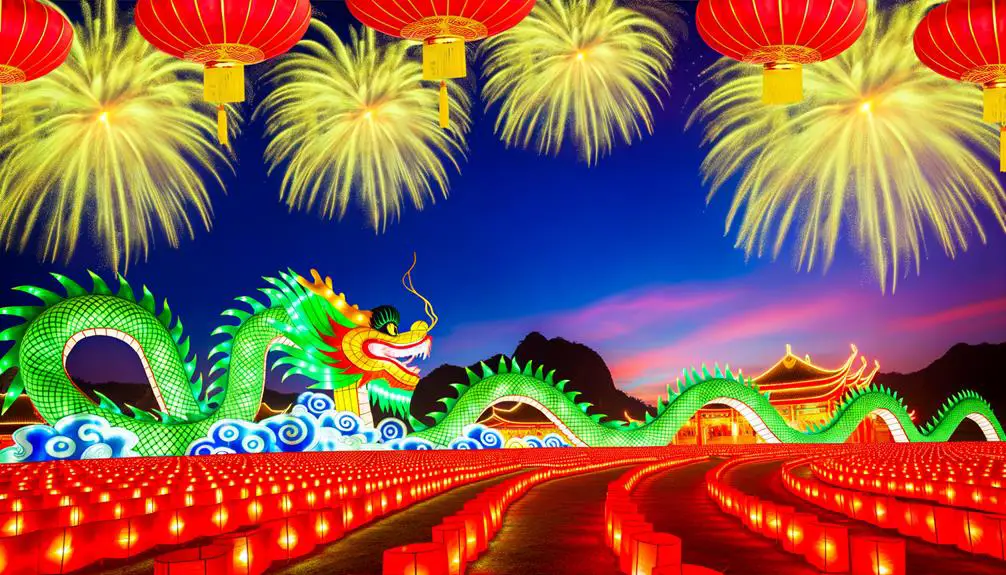
Rooted in the same rich cultural tapestry that venerates the dragon, the mythical origins of Chinese New Year symbols trace back to ancient legends and folklore. These narratives often feature celestial beings and supernatural creatures, providing a framework for understanding the cultural significance of the New Year. The mythological context imbues the holiday with layers of meaning, blending historical traditions and cosmological beliefs.
| Mythical Element | Cultural Significance |
|---|---|
| Nian Monster | Symbolizes overcoming adversity |
| Jade Emperor | Represents celestial authority |
| Lanterns | Signify guidance and illumination |
| Firecrackers | Ward off evil spirits |
These elements collectively contribute to the rich tapestry that forms the basis of Chinese New Year, encapsulating a blend of reverence, celebration, and cultural continuity.
Dragon Characteristics
Embodying both grandeur and power, dragons in Chinese culture are revered as auspicious symbols representing strength, wisdom, and protection.
Historically, dragons were considered to control water-related phenomena, such as rains and floods, reflecting their integral role in agricultural societies.
In Chinese mythology, dragons are often depicted with a serpentine body, scaled skin, and the ability to fly without wings, embodying the amalgamation of various animal traits. These characteristics underscore the dragon's multifaceted nature, illustrating its dominance over both terrestrial and celestial domains.
The dragon's association with the Emperor further emphasizes its embodiment of supreme authority and governance.
Understanding these attributes is essential for appreciating the dragon's enduring presence in Chinese cultural traditions and its symbolic resonance during the New Year celebrations.
Cultural Significance
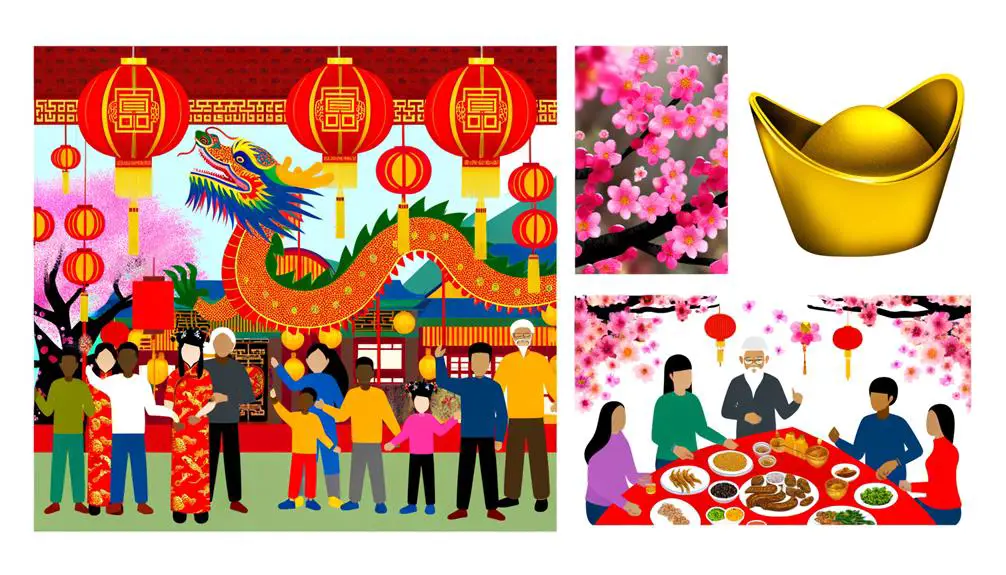
The cultural significance of the dragon in the context of Chinese New Year 2024 is deeply rooted in historical traditions and symbolic meanings.
Historically, the dragon has been revered as a powerful emblem of imperial authority, prosperity, and good fortune.
Symbolically, the dragon embodies strength, courage, and auspiciousness, making it a central figure in the celebration of the Lunar New Year.
Historical Background
Since ancient times, the Chinese New Year has been imbued with profound cultural significance, reflecting the rich tapestry of traditions and beliefs that define Chinese civilization.
Rooted in agrarian society, the festival marked the end of winter and the beginning of the planting season, symbolizing renewal and hope. Historical texts trace its origins to the Shang Dynasty (1600-1046 BCE) when people offered sacrifices to deities and ancestors, seeking blessings for the coming year.
Over centuries, the celebration evolved, incorporating Confucian, Buddhist, and Daoist elements, thereby enriching its cultural fabric.
Rituals such as cleaning homes, setting off fireworks, and displaying red decorations are historical practices aimed at warding off evil spirits and attracting good fortune, underscoring the festival's enduring legacy.
Symbolic Meanings
How do the myriad symbols associated with Chinese New Year encapsulate the intricate tapestry of cultural values and beliefs that have been meticulously preserved through millennia? The rich symbolism inherent in decorations, food, and rituals embodies essential tenets of Chinese culture such as prosperity, longevity, and unity. These emblems, deeply rooted in historical and mythological contexts, offer a lens through which the dynamic interplay between tradition and modernity can be examined.
| Symbol | Meaning | Cultural Context |
|---|---|---|
| Red Lantern | Prosperity | Illuminates homes, warding off evil. |
| Dragon Dance | Strength & Power | Celebrates mythical creatures of lore. |
| Oranges | Wealth | Symbolizes gold, bringing good fortune. |
Understanding these symbols reveals the profound reverence for heritage that continues to shape Chinese New Year celebrations today.
Dragon in Art
The depiction of dragons in Chinese art has historically embodied the cultural significance and mythological reverence attributed to these majestic creatures. Traditional dragon imagery often features intricate designs and specific color schemes, each hue carrying its own symbolic meaning.
In contemporary art, modern interpretations of dragons reflect both a continuation of historical motifs and innovative adaptations that resonate with current artistic trends.
Traditional Dragon Imagery
In traditional Chinese art, the dragon is often depicted as a powerful and auspicious symbol, embodying cultural values and historical significance. This mythical creature is celebrated for its:
- Authority and Power: Representing imperial strength and heavenly mandate, dragons are associated with the emperor.
- Good Fortune: Considered harbingers of prosperity, they are believed to bring rain for bountiful harvests.
- Wisdom and Benevolence: Symbolizing intelligence and good-heartedness, dragons are often seen as protectors.
- Cultural Unity: Their presence in art serves to unify various Chinese ethnic groups under a shared heritage.
Dragons in traditional Chinese art are depicted with serpentine bodies, scaled skin, and features of various animals, reflecting their composite nature and the cultural synthesis they represent.
Dragon Colors Significance
While the dragon's form in traditional Chinese art carries profound cultural symbolism, the colors used to depict these mythical creatures further enhance their significance.
Historically, different colors have been meticulously chosen to convey various attributes and meanings. For instance, red dragons symbolize good fortune, joy, and prosperity, often seen during festive events like the Chinese New Year.
Golden dragons represent wealth, power, and wisdom, reflecting the imperial connection. Blue or green dragons are associated with the east, spring, and growth, embodying renewal and energy.
Black dragons, though less common, denote authority and control over water elements. The chromatic choices in dragon depictions are deeply embedded in Chinese cultural and historical contexts, enriching the narrative of these legendary beings.
Modern Dragon Interpretations
Modern interpretations of dragons in Chinese art often reflect a harmonious blend of traditional symbolism and contemporary aesthetics, showcasing how these mythical creatures continue to evolve in cultural relevance. Historically, dragons have symbolized power, strength, and good fortune in Chinese culture. Today's artists infuse these ancient motifs with modern techniques and media, allowing for a dynamic reinterpretation that resonates with contemporary audiences.
These modern depictions are not merely decorative but serve as cultural bridges linking past and present.
- Digital Art: Utilizing advanced software to create intricate dragon designs.
- Street Art: Incorporating dragon imagery in urban murals to reflect cultural pride.
- Fashion: Embedding dragon motifs in modern clothing and accessories.
- Film and Animation: Bringing dragons to life through cutting-edge CGI and storytelling.
Through these avenues, dragons maintain their revered status while adapting to modern contexts.
Traditional Celebrations
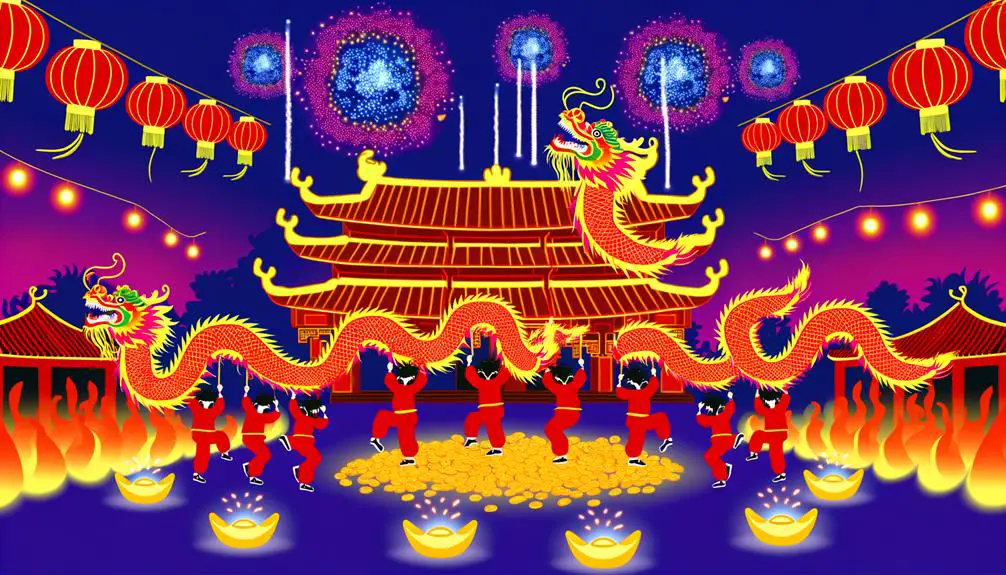
Traditional celebrations of the Chinese New Year, deeply rooted in millennia-old customs, encapsulate a rich tapestry of rituals and cultural symbolism that continue to be observed with fervor across the globe. Historically, these celebrations mark the end of winter and the onset of spring, symbolizing renewal and prosperity.
Rituals such as the thorough cleaning of homes, known as 'sweeping away the dust,' aim to remove ill fortune and invite good luck for the coming year. The family reunion dinner, featuring dishes imbued with symbolic meanings, emphasizes familial bonds and abundance. Additionally, the exchange of red envelopes (hongbao) containing money signifies the transfer of wealth and good wishes.
These practices reflect a profound cultural heritage that bridges past and present.
Dragon Dances
The Dragon Dance, a pivotal element of Chinese New Year festivities, carries profound historical significance as it symbolizes power, dignity, and auspiciousness in Chinese culture. Historically, these elaborate performances have been integral to warding off evil spirits and ensuring a prosperous year ahead.
In contemporary celebrations, the Dragon Dance retains its cultural reverence while also embracing modern interpretations, thereby bridging ancient traditions with present-day festivities.
Historical Significance
Dragon dances, an integral part of Chinese New Year celebrations, have deep historical roots tracing back to the Han Dynasty (206 BCE – 220 CE), reflecting both cultural symbolism and communal unity. These majestic performances are imbued with rich historical significance, embodying the following elements:
- Cultural Symbolism: Dragons symbolize power, dignity, and auspiciousness in Chinese culture.
- Ritualistic Functions: Historically, dragon dances were performed to invoke rain and guarantee a good harvest.
- Social Cohesion: The communal aspect of the dance fosters unity among participants and spectators.
- Artistic Expression: The intricate movements and elaborate costumes of the dragon dance represent high levels of craftsmanship and artistic endeavor.
These facets underscore the dragon dance's enduring significance in Chinese heritage, offering a lens through which to appreciate its historical depth.
Modern Celebrations
In contemporary Chinese New Year festivities, the dragon dance remains a vibrant expression of cultural identity and collective memory, adapting to modern sensibilities while preserving its ancient roots. This dynamic performance, once confined to traditional settings, now features prominently in urban celebrations and international festivals. The evolution of the dragon dance can be observed through variations in costume design, musical accompaniment, and choreography, reflecting an amalgamation of historical reverence and modern creativity.
| Aspect | Traditional Elements | Modern Adaptations |
|---|---|---|
| Costume Design | Handmade silk and bamboo | Synthetic materials, LED lights |
| Musical Accompaniment | Traditional drums and cymbals | Digital sound systems |
| Choreography | Slow, deliberate movements | Fast-paced, acrobatic routines |
| Performance Venues | Temples and local communities | Global stages and public squares |
| Symbolism | Protection from evil spirits | Cultural pride and global unity |
This blending of past and present underscores the dragon dance's significance in both preserving heritage and embracing contemporary culture.
Red Envelopes Tradition
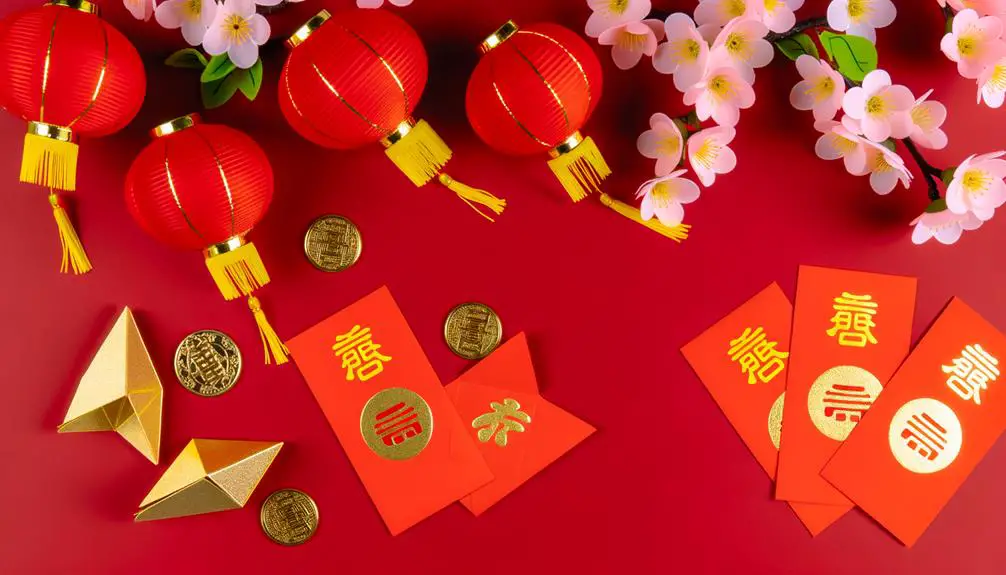
Often signifying good fortune and prosperity, the tradition of giving red envelopes during Chinese New Year holds deep historical and cultural significance. Originating from ancient practices to ward off evil spirits, these envelopes, known as 'hongbao' in Mandarin, are typically filled with money and given to children and unmarried adults. The red color symbolizes luck and wards off malevolent forces.
Key aspects of this tradition include:
- Symbolism: Red envelopes are believed to bring happiness and blessings.
- Etiquette: The amount of money should be even, avoiding the number four due to its association with death.
- Recipients: Traditionally given by elders to younger family members.
- Modern Variations: Digital red envelopes are now popular, reflecting technological advancements.
This practice underscores the enduring values of prosperity and familial bonds in Chinese culture.
Festive Foods
Just as red envelopes symbolize good fortune and familial bonds, festive foods play a pivotal role in the celebration of Chinese New Year, embodying rich cultural traditions and historical significance.
Dishes such as dumplings, symbolizing wealth due to their resemblance to ancient Chinese currency, and fish, representing abundance and surplus, are meticulously prepared and consumed.
The round shape of sweet rice balls signifies reunion and unity among family members. Nian Gao, a glutinous rice cake, is associated with progress and prosperity due to its homophonic resemblance to the phrase 'higher year.'
Each culinary element is imbued with auspicious meanings, reflecting the profound cultural emphasis on harmony, prosperity, and longevity, thereby reinforcing the communal and spiritual fabric of the New Year festivities.
Dragon Decorations
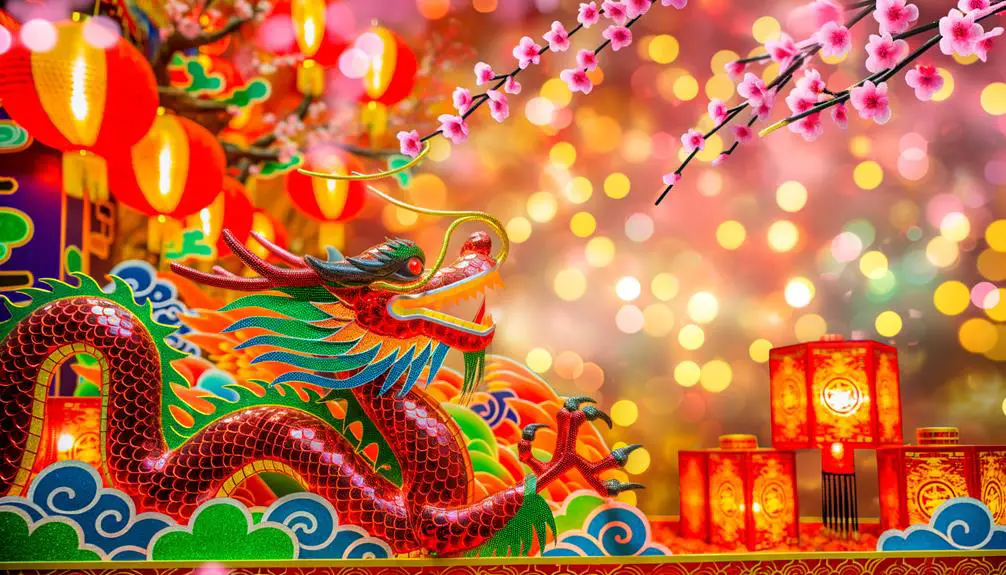
Dragon decorations, essential to the celebration of Chinese New Year, epitomize power, strength, and good luck, deeply rooted in Chinese mythology and cultural heritage. Historically, dragons have been venerated as benevolent creatures, emblematic of imperial authority and natural elements such as water and rain. Their presence during festivities is believed to ward off evil spirits and ensure a prosperous year ahead.
Key features of dragon decorations include:
- Color Symbolism: Mainly red and gold, representing joy and wealth.
- Material Usage: Constructed from paper, silk, and bamboo for intricate designs.
- Dragon Dances: Performed to invoke blessings and communal harmony.
- Cultural Artifacts: Incorporated in lanterns, banners, and traditional attire.
The importance of dragon motifs underscores their enduring significance in Chinese cultural rituals.
Dragon in Modern Times
While traditional dragon decorations remain deeply rooted in Chinese New Year celebrations, the symbolism of the dragon has also evolved to resonate within contemporary contexts and modern-day practices.
Historically a symbol of power, prosperity, and auspiciousness, the dragon has been adapted into various facets of modern life, from corporate branding to digital media. Cultural narratives continue to infuse the dragon with relevance, often portraying it as a guardian figure in video games and animated films.
Additionally, the dragon's image is frequently utilized in marketing campaigns, particularly in the luxury goods sector, to evoke a sense of prestige and excellence. Consequently, the dragon retains its mythical allure while adapting to the dynamic expressions of modern culture.
Conclusion
The symbol for Chinese New Year 2024, the Dragon, embodies profound mythical origins and rich cultural significance. Renowned for its potent characteristics, the Dragon serves as a beacon of strength, prosperity, and good fortune.
Traditions such as red envelopes and festive foods further enhance the celebratory atmosphere. Dragon decorations and the creature's presence in modern times underscore its enduring impact.
Ultimately, the Dragon remains a venerable emblem of Chinese heritage and New Year festivities.

